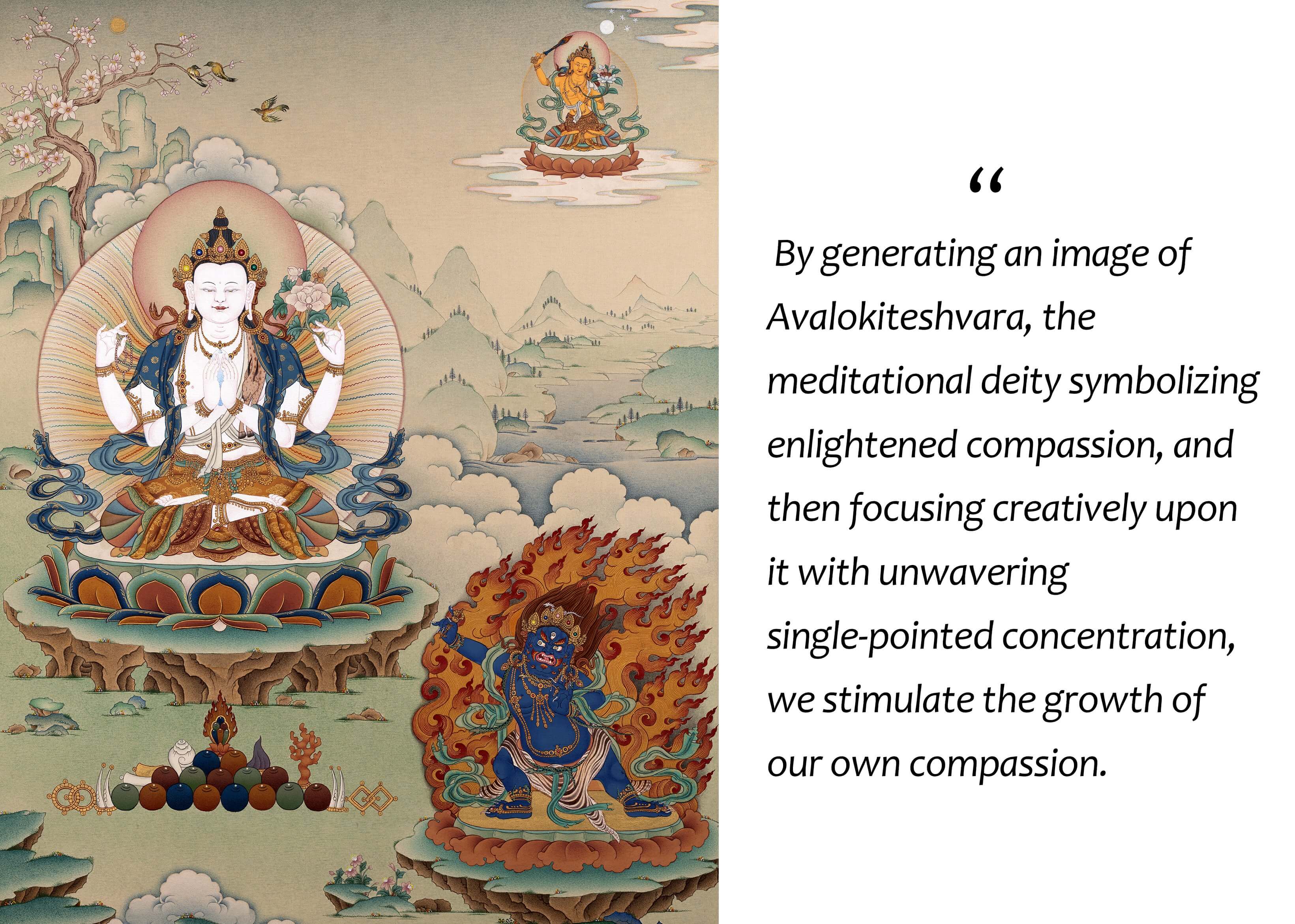Tibetan Thangka Painting: Visualization of Vajrayana Images
The key for understanding the Vajrayana in general and its art in particular lies in the transmission of instruction and insight originating with Shakyamuni Buddha and passed down to the present day through unbroken lineages of accomplished masters. The sacred content of the Tibetan thangka paintings play a vital role in this process of enlightening transmission. To understand how these images are used in Vajrayana, we must consider the centrally important meditational method known as visualization.
Visualization is the process of becoming intimately acquainted with positive and beneficial states of consciousness as they are envisioned in our mind's eye in the form of enlightened beings and other images.
Each visualized image functions as an archetype, evoking responses at a very subtle level of our being and thereby aiding in the delicate work of inner transformation.
For example, by generating an image of Avalokiteshvara, the meditational deity symbolizing enlightened compassion, and then focusing creatively upon it with unwavering single-pointed concentration, we stimulate the growth of our own compassion. We automatically create a peaceful inner environment into which the dissatisfied, self-centered thoughts of anger and resentment cannot easily intrude. The more we practice such visualizations-and the related disciplines, or yogas, that train our body, speech and mind, the more profound are the results.
Eventually our mind can take on the aspect of its object to such an extent that we transcend our ordinary limited sense of self-identification and actually become Avalokiteshvara: compassion itself, or whatever enlightened quality we have been concentrating upon.
For the process of visualization to have its most profound effect and to assist the process of enlightened self-transformation, taking occasional glance at the images is clearly not enough.
" Vajrayana paintings are not meant as decorative wall-hangings to be admired once in a while or looked at occasionally for fleeting inspiration. Instead, their images are to be internalized to the point that we identify with them intimately at the deepest level of our being."
While we may begin by looking at the painting of a particular deity with our eyes, true visualization only takes place when we can hold this image clearly in our mind without forgetting it. Nor are we meant to be visualizing a flat, inert painting of limited dimensions but rather a living, radiant being of light who may appear infinitely large or small depending upon the specific meditation we are practicing. It is only by seeing the meditational deity as truly alive yet transparent, radiant and empty of concrete self-existence, that our mind- which itself is boundless, clear and luminous-can be transformed in the desired manner.
One reason the Vajrayana practitioner can see the various meditational deities as alive is that these figures represent forces possessing a vital reality of their own. They are not mere arbitrary creations of a limited mind or the fanciful product of an artist's imagination. Each particular image owes its existence to the fully enlightened mind from which it originally sprang and conveys the timeless qualities of such a boundless consciousness. Furthermore, the serious practitioner does more than merely chance upon a particular image somewhere and casually decide to make it the central object of his or her meditation. Instead, the deity to be practiced is presented to the disciple within the context of an initiation, or ceremony of empowerment (Skt. abhisheka; Tib. wang), presided over by a qualified tantric master in whom the disciple has already placed his or her confidence This master has trained in the methods of the deity in question and can therefore transmit to the disciple all that is tacting its essence.
During the empowerment and the practices that follow, the disciple sees the deity and the master as indistinguishable from one another and from the lineage of enlightened masters stretching back to Shakyamuni Buddha himself. Far from being a static image, the meditational deity is revealed as the living embodiment of the enlightened energy and inspiration that pervades the entire external and internal universe. The sign of successful practice is the direct, intuitive experience that the mind of the spiritual master, the visualized meditational deity and the practitioner's own mind form an inseparable unity. When this experience is stable, the desired transformation has taken place, and the former disciple is now qualified to take his or her place in the ongoing lineage of accomplished masters and pass on the seeds of enlightening inspiration to others.
The underlying premise of all Vajrayana thought and practice is that the essential nature of each being's mind is pure and clear and that the main task along the spiritual path is to discover and identify with this essential purity, or buddha-nature. Visualization and other related practices involving the images of meditational deities assist this process of discovery and identification because these images directly communicate the experience of those who have already realized this essential purity to those who have not yet done so. The most important function of a realized spiritual master, is to reveal to us the true nature of our own mind. Thus the key to understanding Vajrayana art and following the Vajrayana path is found in the Guru-disciple relationship;
This is the true vehicle of enlightened inspiration.


